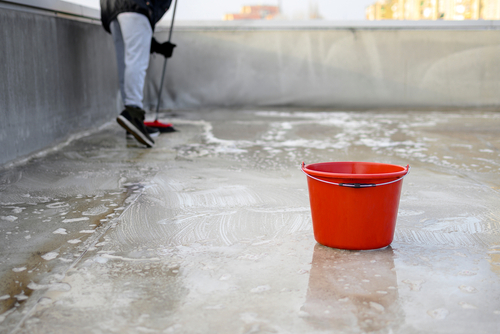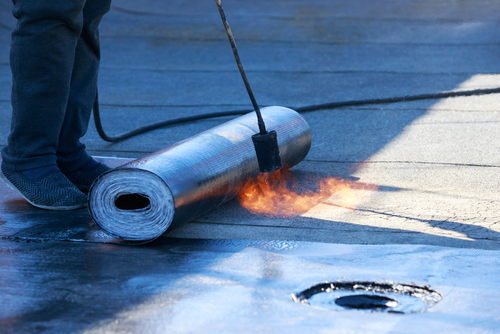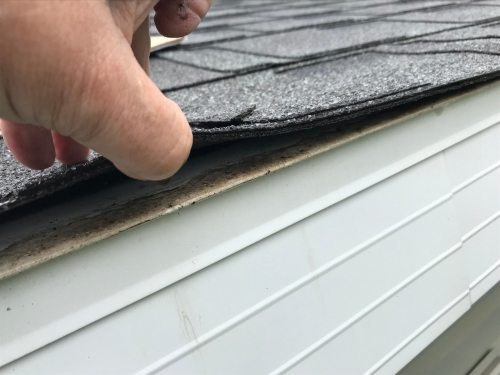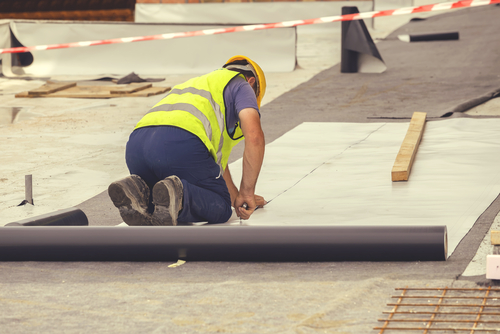
Finding The Right Waterproofing Contractor in Singapore
September 28, 2022
8 Maintenance Tips After Waterproofing Service
December 28, 2022How To Waterproof A Flat Roof?

How To Waterproof A Flat Roof? A flat roof is prone to leaks and damages mainly due to flooding of the water from rainwater, so what you need to do is waterproof it. Waterproofing is the process of protecting something from the effects of water. Matching the correct type of roofing material to your building’s needs is a crucial step in this process.
This is because not all waterproofing materials are suitable for every kind of roof. By waterproofing your roof correctly, you eliminate water from damaging the building and keep it safe from further damage.
Table of Contents
Ultimate guide on how to waterproof a flat roof

1. Clean the Roof and Make the Sand Putt
Before you start waterproofing, you must prepare the surface of your flat roof by cleaning it. It would be best if you used a long-handle broom to remove leaves and dirt from your top. To remove moss and other vegetation, use a garden hose and then broom it off using a fan brush to eliminate them.
Then, before putting down tarps or tar shingles, ensure the sand is put in. After ensuring that all the sand is put in all parts of the roof surface, including eaves and gutters, you can decide which type of tarps will work best for your building’s needs. The tarps come in different weights and sizes, each serving other functions. You have many choices for use, from light tarps to heavy-duty tarps.
2. Leak Testing
Before you install your waterproofing material on the roof, you’ll need to check it for leaks. You can do this by spraying it with water from a garden hose or another source that is deemed safe. This will give you an idea of how easy the material is to install by determining its adhesiveness, as well as giving you an idea of how it will hold up against water pressure over time.
You want to ensure that when you install your material on the roof, it sticks very well and doesn’t slide or fall off. You can also check the adhesion using a straight-edge tool to rub against surfaces like asphalt shingles. If it is not sticking, then it is not suitable for use.
3. Make Sure the Gutters are Clear
Before waterproofing your flat roof, please make sure the gutters are clear. This is because water will end up accumulating in them and then possibly leaking onto other parts of the building, which causes damage.
You have to make sure that the gutters are cleared out. Otherwise, if it rains and water gets into the channels, it may leak into your structure through your flat roofing material. If you don’t have gutters installed on your roofing structure, you can use a gutter guard or a downspout extension to help prevent water damage to your building.
4. Installing the Material

Once you have cleared out your gutters and done the leak test, you can begin installing your material on the roof. If you use a tarp, could you ensure it is adequately anchored? It should be anchored by staking it down using extra-long ground screws or spikes.
You need to staple or nail every single side of it to the main structure of your building, including trusses. Could you ensure you follow all the guidelines for installing tarps for your waterproofing flat roof job to be done correctly and effectively?
5. Caulking
After installing the tarps, you need to caulk around the entire perimeter of your building so that water is prevented from entering through cracks and other similar sources. Make sure you caulk cracks or holes noticed on your building by either a professional inspector or a contractor who may have built your structure.
Caulk comes in different colors and sizes, so choose the appropriate size and color for you based on how extensive the cracks are. If too many gaps exist, you will need to use more caulk. The caulking will be used, and a caulking gun and a caulking tool to apply correctly.
6. Inspecting the Roof

After you have done all the above-described steps, it is time to look over your roof. Inspect it after every few weeks to be sure that there are no leaks and no damage has occurred.
It will take some effort, but if you take your time and ensure that everything is working correctly during the whole process, you will end up with a suitable waterproofing flat roof job with little to no damage caused to the structure of your building. To check for water leaks thoroughly, use a pressure washer that can reach up to 2000 PSI (pounds per square inch).
This will help to remove the dirt from the roof. Cleaning the top with a pressure washer is often necessary and recommended by professionals to prevent the growth of moss, algae, mold, and other vegetation that are likely to cause leaks and damage when they begin to break down.
Hiring a Professional
You must hire a professional if you need more tools or knowledge to waterproof your roof. An experienced waterproofing contractor will be equipped with all the tools and expertise necessary to properly waterproof any flat roof. They will be able to use high-quality materials in your building so that you are guaranteed an excellent job.
They also know how to complete their work promptly without compromising quality or security. This is why it is essential that before starting any waterproofing project, you hire a professional to ensure everything goes according to plan and no mistakes are made during installation.
How To Waterproof A Flat Roof? – Conclusion

Waterproofing a flat roof is an essential part of building maintenance. If you don’t do it regularly, you risk the roof leaking and causing damage to your building structure. This is especially true if you live in a climate where rain storms are expected. Other than the roof itself, the gutters are also essential to route away rainwater and prevent them from getting into the building.
Cleaning out the gutters regularly is necessary to avoid any unnecessary leaks. If you want your flat roof to serve its purpose well, then you need to make sure that any vegetation grown on your roof’s surface is removed as soon as possible before it causes damage or leaks.




